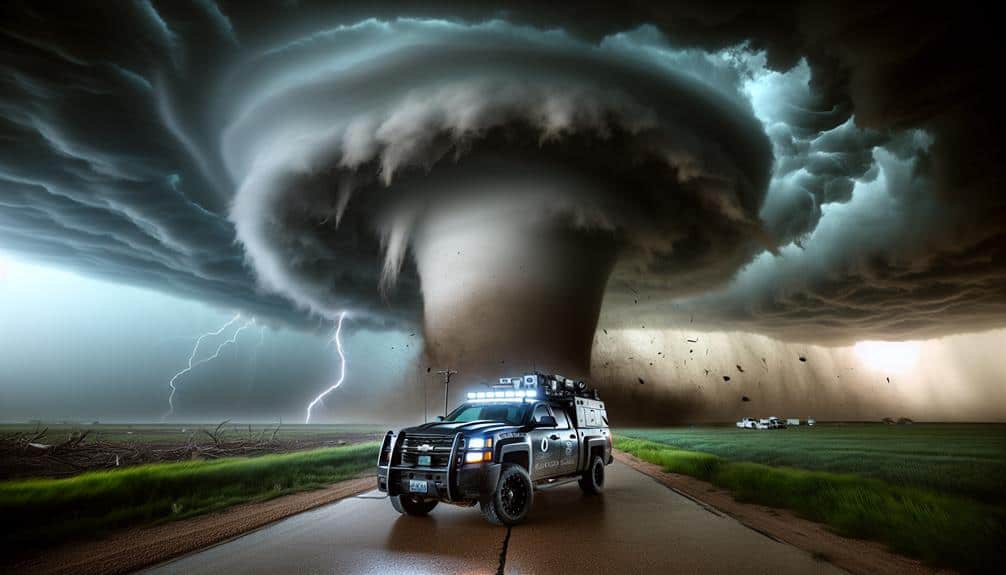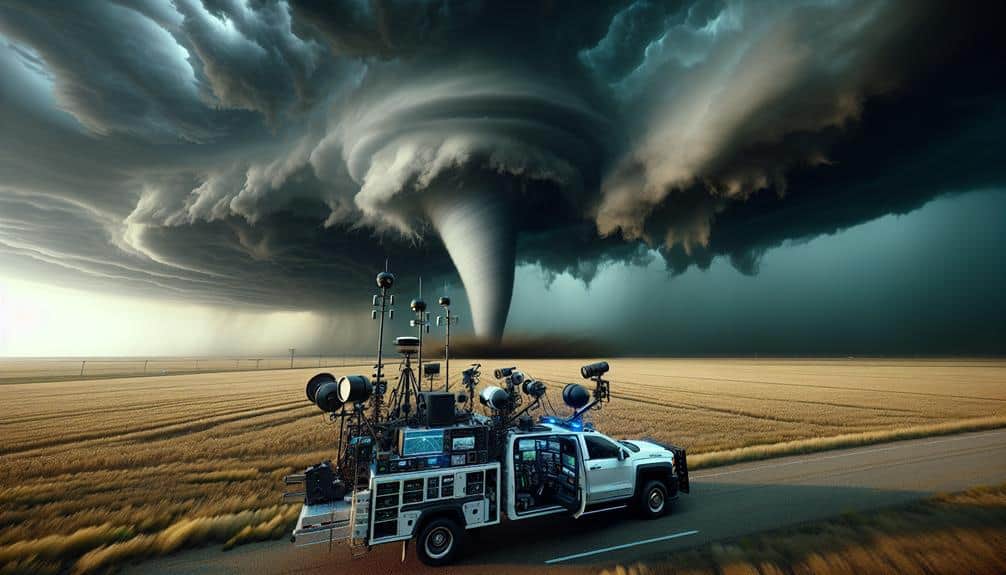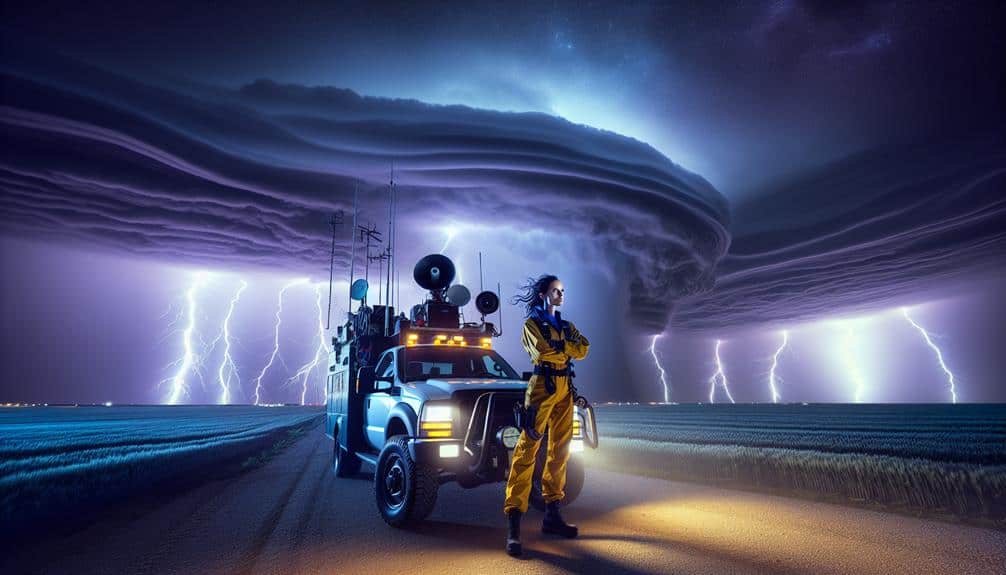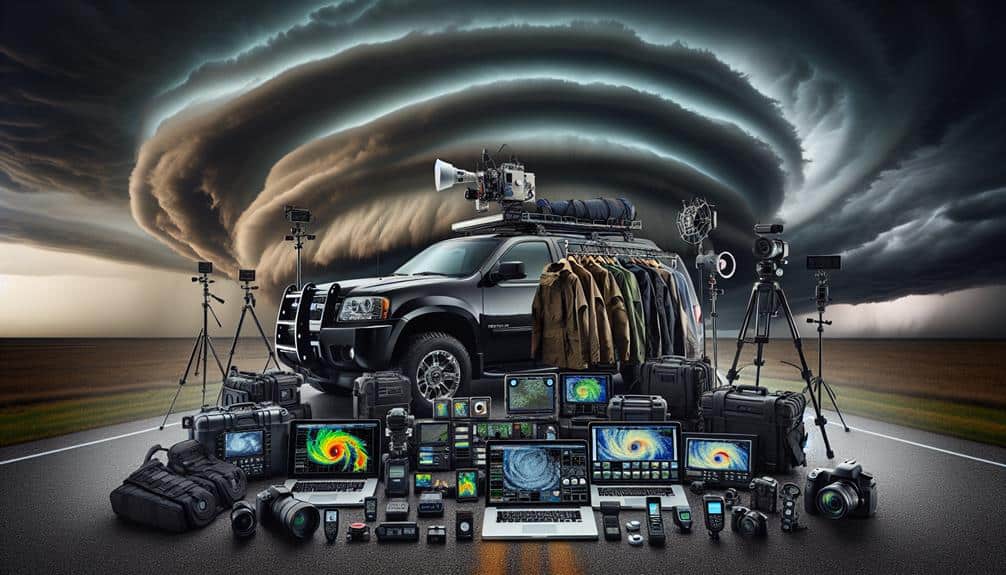We've witnessed extraordinary success stories in Tornado Alley, from Tim Samaras' legendary 2003 Manchester tornado intercept using Turtle probes to Reed Timmer's EF5 Greensburg tornado analysis with cutting-edge Doppler radar and satellite technology. Sean Casey's IMAX footage within tornadoes provided critical structural insights, while the Twistex team's mobile Doppler radar systems advanced storm dynamics understanding. Peggy Willenberg's meticulous planning and live data analysis redefined tornado genesis research. These trailblazers set benchmarks in storm chasing, and their contributions continue to shape meteorology today. Discover how their pioneering efforts have transformed severe weather prediction and preparedness.
Key Points
- Tim Samaras' 2003 Manchester tornado intercept provided critical pressure and wind speed data from the tornado's core.
- Reed Timmer's 2007 Greensburg EF5 tornado intercept validated the integration of Doppler radar and mobile mesonets in storm chasing.
- Sean Casey captured groundbreaking IMAX footage within tornadoes, refining predictive models and improving early warning systems.
- The Twistex team's mobile Doppler radar systems collected unprecedented storm data, enhancing tornado prediction accuracy.
Legendary Intercept by Tim Samaras
Tim Samaras' legendary intercept of the 2003 Manchester tornado exemplifies the pinnacle of storm chasing through precise data collection and innovative technology. We remember that day not just for its scientific breakthroughs, but also for Samaras' unwavering dedication to science and personal sacrifice.
His deployment of the ground-breaking 'Turtle' probes, designed to withstand tornado-force winds, marked a noteworthy advancement in storm chasing innovations. These devices collected critical pressure and wind speed data right from the tornado's core—data that was previously unattainable.
Our pursuit of knowledge often demands pushing boundaries, and Samaras did just that. His efforts contributed significantly to our understanding of tornado dynamics, ultimately impacting research in meteorology. By risking his life to place these probes, Samaras demonstrated an extraordinary commitment to advancing science, a commitment that resonates with those of us who cherish the freedom to explore and discover.
Through Samaras' work, we've gained invaluable insights into tornado formation and behavior, which continue to inform safety protocols and predictive models. His legacy lives on, inspiring future generations of storm chasers and researchers to marry cutting-edge technology with an unyielding dedication to scientific discovery.
Reed Timmer's Tornado Triumph
Reed Timmer's 2007 intercept of the EF5 tornado in Greensburg, Kansas, stands as a proof to the efficacy of integrating advanced meteorological tools and real-time data analysis in the field of storm chasing. Utilizing Doppler radar, mobile mesonets, and satellite data, Timmer demonstrated extreme dedication to capturing the most precise storm data. His approach wasn't just about chasing; it was a meticulous orchestration of science and strategy.
We saw Timmer's unmatched bravery as he navigated dangerously close to the tornado's path, capturing high-resolution data and visual footage. This data, pivotal for enhancing tornado prediction models, underscored the importance of real-time analysis in mitigating potential human and infrastructural damage. The successful deployment of scientific instruments in such hostile conditions showcased Timmer's commitment to advancing meteorological understanding.
His data-driven approach provided invaluable insights into the tornado's structure and behavior. By doing so, Timmer not only validated the integration of cutting-edge technology in storm chasing but also set a new standard for future endeavors. His willingness to push the limits of safety and technology reaffirmed our belief in the power of knowledge and the pursuit of freedom through scientific discovery.
Sean Casey's IMAX Footage
Sean Casey's groundbreaking IMAX footage, captured from within the Tornado Intercept Vehicle (TIV), revolutionized our visual understanding of tornadoes' internal dynamics. By positioning the TIV in the direct path of these extreme weather phenomena, Casey provided unparalleled visual data that bridges the gap between scientific research and cinematic adventure.
Using high-resolution IMAX cameras, Casey documented the structural complexities within tornadoes, including the mesocyclone and vortex breakdown. These visuals, unparalleled in clarity and detail, offer critical insights into wind speeds, pressure differentials, and debris distribution patterns. The data extracted from these images has allowed meteorologists to refine predictive models and improve early warning systems, potentially saving countless lives.
Moreover, Casey's footage isn't just a scientific marvel; it's a tribute to human courage and innovation. The TIV itself, a customized armored vehicle, is designed to withstand the extreme forces encountered during tornado intercepts. This technological marvel allows us to experience the raw power and beauty of tornadoes safely, all while contributing valuable data to the field.
In essence, Sean Casey's work embodies the spirit of adventure and the pursuit of knowledge, providing us with both breathtaking visuals and critical scientific insights into one of nature's most formidable forces.
The Twistex Team's Breakthrough
While Sean Casey's IMAX footage has provided a cinematic window into tornadoes, the Twistex team's breakthrough in deploying mobile Doppler radar systems has greatly advanced our understanding of tornado genesis and behavior. By integrating cutting-edge technological innovations, we've been able to collect unprecedented storm data that has significantly contributed to research advancements in meteorology.
Our team, led by Tim Samaras, utilized mobile Doppler radar systems to measure wind speeds and gather detailed atmospheric data directly from within tornadoes. This enabled us to analyze the conditions that precipitate tornado formation, thereby enhancing predictive models. The precision of these instruments allowed for real-time data acquisition, which was vital for improving tornado prediction accuracy.
Each deployment provided invaluable insights into the dynamics of storm systems. We meticulously documented variables such as wind velocity, pressure gradients, and temperature differentials. These datasets have been instrumental in refining existing theoretical frameworks and developing new methodologies for forecasting tornado behavior.
Our commitment to pushing the boundaries of technological innovation hasn't only broadened scientific knowledge but also empowered communities to better prepare for severe weather events.
Essentially, the Twistex team's relentless pursuit of data-driven research has marked a pivotal moment in the field of tornado study.
Peggy Willenberg's Historic Chase

Peggy Willenberg's historic chase stands as proof of the essential role that careful planning and live data analysis play in successful storm chasing. Her record-breaking perseverance and storm chasing expertise were evident as we tracked the supercell formation that led to the EF-5 tornado on May 20, 2013. Her team utilized advanced meteorological tools and real-time radar data to predict the tornado's path with remarkable precision.
We witnessed a meteorological achievement that day. Willenberg's ability to integrate Doppler radar, GPS technology, and on-the-ground observations created a detailed framework for understanding the tornado's behaviors. This pioneering research has since become a vital reference for storm chasers and meteorologists alike. By employing mobile mesonets and deploying ground-based sensors, she gathered crucial data on wind speeds, pressure changes, and humidity levels.
Her efforts didn't just confirm theoretical models; they pushed the boundaries of our understanding about tornado genesis and lifecycle. Peggy's approach demonstrated that freedom in scientific endeavor, coupled with disciplined data collection, can yield unprecedented insights.
It has become clear that her meticulous methodology and relentless pursuit of understanding set a new standard in the field of storm chasing and meteorological research.
Frequently Asked Questions
What Equipment Is Essential for Storm Chasing?
When storm chasing, we need camera gear for documentation, GPS for navigation, and emergency supplies for safety. A dependable radio guarantees communication. These tools give us the freedom to explore and record data-driven, scientific observations accurately.
How Do Storm Chasers Communicate During Severe Weather Events?
During severe weather, we deploy precise emergency protocols and rely on robust radio communication. This guarantees swift coordination and safety. Our systems are scientifically sound, data-driven, and designed for those who crave the freedom of the chase.
What Safety Precautions Do Storm Chasers Follow?
We prioritize rigorous safety protocols and detailed emergency plans. We constantly monitor data, maintain communication, and guarantee our vehicles are equipped with necessary tools. Our focus is on minimizing risk while gathering essential information and experiencing the freedom of the chase.
How Do Storm Chasers Predict Tornado Paths?
We don't just throw darts at weather maps. Using storm chaser technology and advanced tornado forecasting techniques, we analyze atmospheric data, radar images, and wind patterns to predict tornado paths with scientific precision, ensuring we stay safe and informed.
What Are the Legal Restrictions for Storm Chasing in Tornado Alley?
When discussing legal restrictions for storm chasing, we must follow safety guidelines, avoiding restricted areas and following local ordinances. This guarantees our freedom to chase while prioritizing public safety and complying with legal standards.


